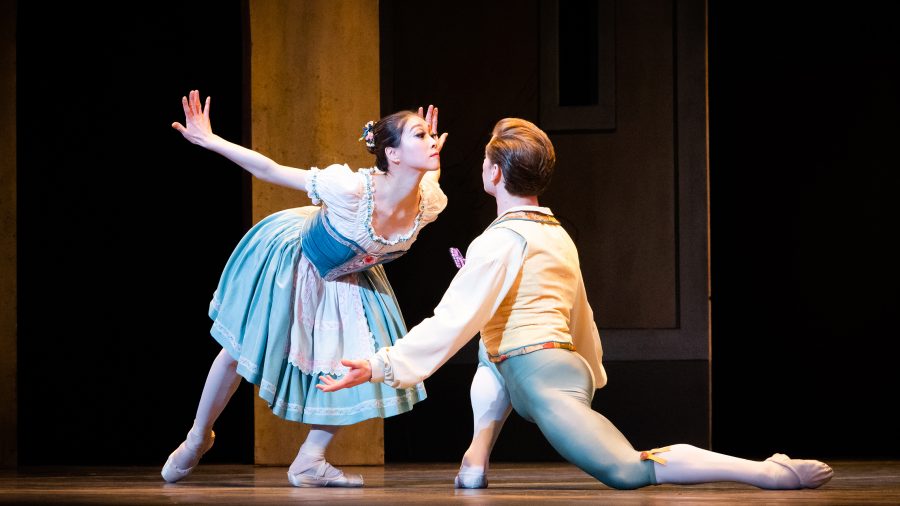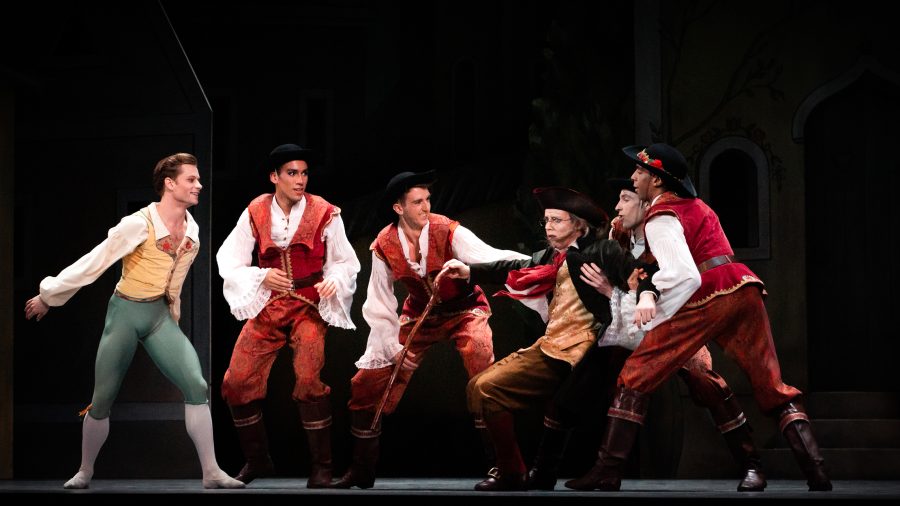March 21—The Boston Ballet debuted its second show of 2019: Coppélia, a light-hearted romantic comedy with music by Léo Delibes, conducted by Mischa Santora and choreographed by George Balanchine and Alexandra Danilova after Marius Petipa’s 1884 version. It tells the story of an Austro-Hungarian village called Galicia preparing for the inauguration of a new bell-tower. In this village lives an old man by the name of Dr. Coppélius, an inventor and creator of a life-like doll named Coppélia, whom he thinks of as his own daughter. She sits on the balcony of Coppélius’ studio and inadvertently attracts the attention of a young man named Franz. Though Franz loves a local girl by the name of Swanhilda, he flirts with the doll, causing a string of shenanigans to ensue. Acts I and II follow these main characters and their antics about the village before culminating in Act III with the Festival of the Bells, featuring Balanchine’s own choreography.
The ballet is held at the Boston Opera House at 539 Washington St. in the Theatre District, a short walk from the Chinatown T station. On passing through security, one is met with three lobbies—upper, middle, and lower—with ornate architecture, setting the tone for the evening. The theatre itself features floor seating as well as a balcony level, with the pit orchestra located just beneath the stage. Plenty of attendants roam about the entrances and aisles, assisting people to their seats with friendly smiles. The ballet also had pre-show interactive stations collectively referred to as ‘The Warm-up,’ in which mini-exhibits were set up in the lower lobby featuring concept art of the costumes and staging, activities for children, a model of how pointe shoes are made, postcards that could be mailed out by the ballet to one’s person of choice, and a photobooth with Coppélia-themed props. The bathroom was also extremely lavish and should most definitely be frequented, even if you don’t have a particular need for it.
The casting for the evening featured principal dancers Misa Kuranaga and Derek Dunn as Swanhilda and Franz respectively, with soloist Isaac Akiba filling the role of Dr. Coppélius in place of Paul Craig. For the first two acts, solos were performed by Kuranaga and Dunn, with a host of other talented dancers playing the roles of the villagers and Swanhilda’s friends. Act III featured a several solos for the Dedication of the Bells scene and Swanhilda and Franz’s wedding, including characters Dawn, Prayer, Spinner, and a pas de quatre by the Jesterettes. They were accompanied throughout their performances by 24 young students of the Boston Ballet School, a pleasant—and quite adorable—surprise. The celebration is interrupted by War and Discord, played by Lia Cirio and Lasha Khozashvli respectively, principal dancers who have both held other leading roles for the company. Eventually, peace returns, and the finale features all of the dancers, as well as a pas de deux by Kuranaga and Dunn.
As for the performance itself, the music and setting truly fit with the ushering in of spring, making it an excellent season opener. Perhaps due to opening night jitters, there were admittedly times when the corps de ballet fell out of sync. That being said, it did not detract much from the beauty of the ballet, and the facial expressions and gesticulation that the dancers imbued throughout their performances clearly communicated the emotions of the scenes—crucial especially to a comedic show. The costumes were stunning and stayed true to the Austro-Hungarian region; the skirts in particular were beautifully layered and the pops of color shined through with every turn. The majority of the solos were in fact performed during Act III—all of which were a delight to watch—but Act II’s performances by Kuranaga were particularly of note as well. The act takes place in Coppélius’ studio, where Kuranaga as Coppélia dances several solos, including Flamenco and Gaelic-inspired pieces. At times, it became a little repetitive, but the quality of the dances and the acting in between kept interest piqued. True to its genre, there were several moments where I found myself and the audience laughing out loud.
All-in-all, Coppélia is just fun to watch. The exaggeration of gestures and facial expressions, the bright colors of the costumes, the composition of the music, and the just straight-up silly nature of the plot itself make for a jovial and playful experience. The venue is stunning, the people are friendly and, for once, security is not an absolute pain to get through (though having your tickets in advance is recommended). Coppélia remains a truly charming comedy for all ages, and the Boston Ballet did wonderfully with its execution.
Coppélia will continue to run from March 21 to March 31. Afterwards the Boston Ballet will put on Cinderella starting on May 10 and ending on June 8.
What a Doll: Opening Night at the Boston Ballet
March 25, 2019
What a Doll: Opening Night at the Boston Ballet






















































